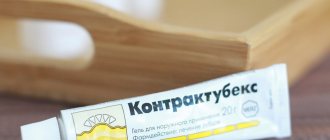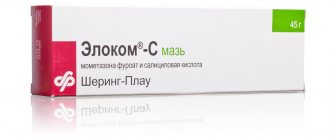How to use
Before using this or that form of the drug, you should definitely consult a specialist. You also need to do a test for the sensitivity of the skin to the constituent components in order to prevent the occurrence of allergic processes.
Ointment
The ointment is applied exclusively to damaged areas of the skin. For maximum results, apply a gauze bandage over the area. You can apply the ointment no more than 3 times a day. You can use up to 1 g of neomycin per day. The dosage for a child does not require adjustment. The duration of the therapeutic course is a week. In certain cases, the specialist may extend the treatment. When prolonging treatment, the dose used should be reduced by 2 times.
Powder
The medicine in this form is convenient to use as a powder on the umbilical wound, as well as for healing scratches. Used to treat injured skin areas. The powder can be used no more than 4 times a day. It must be applied in a thin layer. Up to 200 g of powder can be used per day. For long-term treatment, the dosage should be reduced to 100 g per day.
Baneocin powder for external use (250i+5000i)/1g 10g No. 1
Name
Baneocin por. dnar. approx. 10g
Storage conditions
The drug should be stored out of the reach of children at a temperature not exceeding 25°C.
Expiration date from date of manufacture
2 years
Product description
Fine powder for external use, white to yellowish in color
pharmachologic effect
Combined antibacterial drug for external use. Contains two antibiotics that have a bactericidal effect, neomycin and bacitracin. Bacitracin is a polypeptide antibiotic that inhibits the synthesis of bacterial cell walls. Active against gram-positive (Streptococcus spp. /including β-hemolytic streptococcus/, Staphylococcus spp.) and some gram-negative microorganisms. Resistance to bacitracin rarely develops. Neomycin is an aminoglycoside antibiotic that inhibits bacterial protein synthesis. Active against gram-positive and gram-negative bacteria. Thanks to the use of a combination of these two antibiotics, a wide spectrum of action of the drug and synergistic action against a number of microorganisms, for example, staphylococci, are achieved.
Pharmacokinetics
The active substances, as a rule, are not absorbed (even by damaged skin), however, their high concentrations are present in the skin. When applying the drug to large areas of skin lesions, the possibility of systemic absorption of the drug should be taken into account. Has good tissue tolerance; inactivation by biological products, blood and tissue components is not observed.
Indications for use
Infectious and inflammatory skin diseases caused by microorganisms sensitive to the drug:
- bacterial skin infections of limited prevalence, incl. weeping contagious impetigo, infected trophic ulcers of the lower extremities, infected eczema, bacterial diaper dermatitis, secondary bacterial infection in diseases caused by Herpes simplex, Varicella zoster (including infection of vesicles with chickenpox);
- prevention of umbilical infection in newborns;
- prevention of infection after surgical (dermatological) procedures: for additional treatment in the postoperative period (after tissue excision, cauterization, episiotomy, treatment of cracks, perineal rupture, weeping wounds and sutures).
Use during pregnancy and lactation
The use of Baneocin® during pregnancy and lactation is possible after consultation with a doctor and only if the expected benefit to the mother outweighs the potential risk to the fetus or infant. It should be remembered that neomycin, like all aminoglycoside antibiotics, can penetrate the placental barrier. Intrauterine hearing loss in the fetus has been described with systemic use of aminoglycoside antibiotics in high doses.
special instructions
Since the risk of toxic effects increases with decreased liver and/or kidney function, blood and urine tests together with audiometry should be performed in patients with liver and/or kidney failure before and during therapy with Baneocin®. If absorption of the active components of Baneocin® is possible, it is necessary to monitor the possible appearance of signs of neuromuscular blockade, especially in patients with acidosis, myasthenia gravis or other neuromuscular diseases. If neuromuscular blockade develops, calcium supplements or neostigmine are indicated. With long-term use of the drug, it is necessary to monitor the possible excessive growth of resistant microorganisms. If necessary, appropriate treatment should be prescribed. If the drug is used in children, patients with impaired liver and kidney function, as well as with a large surface area to be treated, long-term use and deep skin lesions, you should first consult a doctor. If allergic reactions and superinfection develop, the drug should be discontinued. Effect on the ability to drive vehicles and operate machinery No special precautions are required.
With caution (Precautions)
The drug should be prescribed with caution to patients with impaired liver and/or renal function, acidosis, myasthenia gravis or other neuromuscular diseases. The drug should be prescribed with caution to patients with impaired liver function. The drug should be prescribed with caution to patients with impaired renal function.
Contraindications
- extensive skin lesions (risk of developing an ototoxic effect accompanied by hearing loss);
- severe impairment of renal excretory function (due to cardiac or renal failure) in patients with existing diseases of the cochleo-vestibular apparatus (if systemic absorption of the drug is possible);
- infections of the external auditory canal with perforation of the eardrum;
- simultaneous use with systemic aminoglycoside antibiotics (risk of cumulative toxicity);
- hypersensitivity to bacitracin, neomycin or other aminoglycosides, auxiliary components of the drug.
Do not use the drug to treat eye infections.
Directions for use and doses
For adults and children, from the 1st day of life, the drug is applied in a thin layer to the affected areas 2-4 times a day; if necessary, under a bandage. The area where the powder is applied should not exceed 1% of the body surface area (which corresponds to the size of the patient's palm). When applied topically, the dose of neomycin for adults and children and adolescents under 18 years of age should not exceed 1 g/day (corresponding to 200 g of powder) for 7 days. Patients with impaired liver/renal function and elderly patients do not require dose adjustment.
Overdose
When used in doses significantly higher than recommended, especially in the treatment of (neuro)trophic ulcers, nephro- and ototoxic reactions may occur due to possible absorption of the active components of the drug Baneocin®.
Side effect
According to WHO, undesirable effects are classified according to the frequency of development as follows: very often (?1/10), often (from?1/100 to
Compound
1 g bacitracin (in the form of bacitracin zinc) 250 IU neomycin (in the form of neomycin sulfate) 5000 IU Excipients: lanolin, white soft paraffin.
Interaction with other drugs
With systemic absorption of the active components of the drug, simultaneous use of cephalosporins or aminoglycoside antibiotics may increase the likelihood of developing nephrotoxic reactions. When using the drug Baneocin® simultaneously with ethacrynic acid or furosemide, the risk of developing oto- and nephrotoxic reactions increases. Absorption of the active components of the drug Baneocin® when used simultaneously with opioid analgesics, anesthetics and muscle relaxants may increase the risk of developing neuromuscular conduction disorders.
Release form
The powder for external use is finely dispersed, from white to yellowish in color. 1 g bacitracin (in the form of bacitracin zinc) 250 IU neomycin (in the form of neomycin sulfate) 5000 IU Excipients: sterilized powder base (corn starch containing no more than 2% magnesium oxide). 10 g - polyethylene jars (1) with dispenser - cardboard packs.
Contraindications and adverse reactions
You should avoid taking Baneocin in the following cases:
- increased susceptibility to constituent components;
- in case of serious skin damage, do not take the drug in the form of an ointment;
- when infected with an infection of the ear canal in the presence of perforating damage to the eardrum;
- for problems with the excretory system;
- for problems with the muscular-nervous system;
- diseases of the visual organs.
You should strictly adhere to the instructions for use and not exceed the permissible dose.
With prolonged use of the product, allergic processes may begin, accompanied by redness, itching and rashes. When treating large skin lesions, systemic negative reactions may occur.
To date, no cases of overdose with Baneocin have been recorded.
special instructions
The shelf life of the medicine in powder form is 24 months from the date of manufacture, in the form of ointment - 36 months. Store at room temperature.
If the substance gets into your eyes, rinse immediately with water.
Before taking the drug, you need to check the microflora that caused the dermatological disease for susceptibility to its constituent elements.
When taken simultaneously with other medications, you should monitor the body’s reaction, and if something happens, immediately consult a doctor.
If a person has problems with the functioning of the kidneys and liver, then he needs to constantly undergo urine and blood tests.
Analogs
There are several drugs that have a similar effect to Baneocin.
Lincomycin in the form of an ointment copes well with inflammatory processes in the skin. The composition also contains neomycin, which affects aerobic microorganisms.
Bonderm ointment is actively used for various skin diseases. Can be used by adults and children. It is also prescribed to prevent infection of sutures, cuts and wounds after surgery. In rare cases, it leads to allergic reactions and other side effects. Can be used during pregnancy and breastfeeding under medical supervision.
Baneocin®
Baneocin® is a combined antibacterial drug intended for external use.
Baneocin® contains two bactericidal antibiotics: neomycin and bacitracin, the combination of which achieves synergistic action. Bacitracin primarily inhibits the synthesis of murein in the cell wall of gram-positive bacteria (and some gram-negative bacteria).
Bacitracin is active primarily against gram-positive microorganisms: Streptococcus hemolyticus, Staphylococcus spp., Clostridium spp., Corynebacterium
diphtheriae ,
and some gram-negative microorganisms:
Neisseria spp.
and
Haemophilus influenzae.
Bacitracin is also active against
Treponema pallidum, Actinomyces spp.
and
Fusobacteria spp.
Resistance to bacitracin is extremely rare.
The effectiveness of neomycin is due in part to an increase in cell membrane permeability due to inhibition of protein synthesis. Neomycin is active against both gram-positive and gram-negative pathogens, such as Staphylococcus spp., Proteus spp., Enterobacter aerogenes, Klebsiella pneumoniae, Salmonella spp., Shigella spp., Haemophilus influenzae, Pasteurella, Neisseria meningitidis, Vibrio cholerae, Bordetella pertussis, Bacillus anthracis, Corynebacterium diphtheriae, Streptococcus faecalis, Listeria monocytogenes, Escherichia coli
and
Mycobacterium tuberculosis.
Also active against
Borrelia
and
Leptospira interrogans (L. icterohaemorrhagiae).
Some strains of staphylococci are resistant to neomycin.
Thanks to the use of a combination of these two substances, a wide spectrum of action of the drug is achieved, with the exception of action against pseudomonas, nocardia, fungi and viruses. Tissue tolerance of the drug Baneocin® is assessed as good; inactivation by biological products, blood and tissue components is not observed.
If the drug is applied to large areas of skin lesions (in violation of the recommended dosage regimen), the possibility of absorption of the drug and its consequences should be taken into account (see sections “Contraindications”, Interaction with other drugs”, “Special instructions” and “Side effects”) .
Baneocin® powder also has a drying, soothing and cooling effect.

